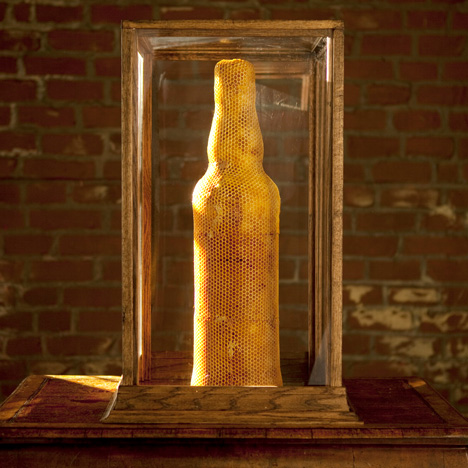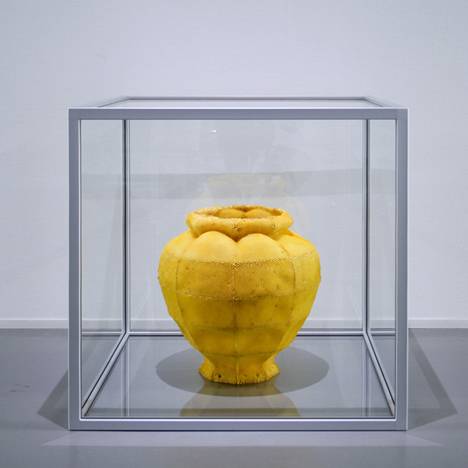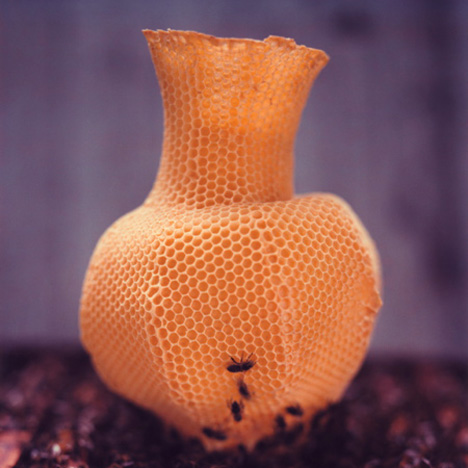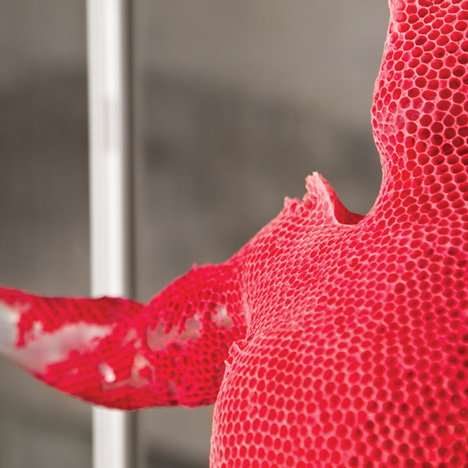Honeycomb vase designer says whisky campaign "unabashedly exploits" his work
News: a designer who developed a technique for harnessing bees to create physical objects has accused a major brand of exploiting his work.

Slovakian designer Tomáš Libertíny contacted Dezeen after seeing a campaign created by New York creative agency Sid Lee for Dewar's Highlander Honey whisky, which features 80,000 bees forming a honeycomb sculpture of a whisky bottle and a bust of Dewar’s "drinking man" symbol.

Libertíny claims the project "unabashedly exploits the poetry" of his own projects, including his 2007 Honeycomb Vase - which is now in the MoMA collection - and 2010's The Unbearable Lightness, both of which were created using a similar process.

"Studio Libertiny is surprised that Sid Lee and Dewar’s (Bacardi) have launched a commercial campaign that unabashedly exploits the poetry of the work of Tomáš Libertíny and his team of artists and designers," Libertíny wrote in a statement to Dezeen.

A short documentary about the Dewar's project, produced by The Ebeling Group and titled "The 3-B Printing Project", features Californian bee-keeper Robin Theron and Los Angeles sculptor and engineer James Peterson explaining how they collaborated to create the honeycomb objects.

To do this, they covered the forms of the bottle and the bust with sheets of beeswax printed with tessellated hexagonal patterns, and enclosed them in transparent cases. The cases were then filled with honey bees, who built a honeycomb structure on top of the forms. "In order for bees to build on the outside of anything, we turned a bee hive inside out," explains Theron. In total, 80,000 bees were used to create the pieces.
Libertíny used a similar process when creating his objects, the first of which was presented in Milan in 2007. "It took 40,000 bees and one week to make a single vase," said Libertíny at the time. "Not meaning it as a euphamism, we called this process "slow prototyping"."

In his statement this week, Libertíny said: "The 3B-Printing campaign is clearly not only inspired by but also follows the concept, storytelling, imagery, techniques and vocabulary of the Slow-Prototyping project that Studio Libertiny has been busy with for years."
"Dewar’s as well as Bacardi are, in their own right, proud of their originality and brand identity which stands in contrast with authenticity of the campaign," he added. "Studio Libertiny hopes that the campaign from Dewar’s will not divert the audience from seeing the relevance of nature (in this case honeybees) and the importance of it to humankind’s survival."
Sid Lee admitted that the project was inspired by Libertíny's work but said a "slightly different process" was used in the campaign.
"You are right in calling out that we got inspired by Thomas [sic] Libertiny," said Sid Lee managing partner Lukas Derksen, "as well as earlier artists that inspired Thomas like sculptor Garnett Puett with his project called Apiscaryatid in the late 1980s and young New York-based artists such as Hilary Berseth with her well known work called Programmed Hives in 2008."
He added: "As you can see in our documentary we pursued a slightly different process than these artists did before us, and engineered moulds that would hold the bees in order to sculpt the bottle and the bust in even more precision."
Mark Corran of London intellectual property lawyers Briffa said it would be "very difficult" for Libertíny to protect himself against people wanting to copy his technique. "The question is, would consumers be confused by the advert into thinking it was his work?" said Corran, saying that depended on how well known Libertíny and his work is to the general public. "He hasn't got a monopoly on this process."
The row follows recent accusations of plagiarism including claims that British designer Thomas Heatherwick copied the design for the London 2012 Olympic cauldron, and the discovery of a copy of a Zaha Hadid building in China.
See our recent round-up of stories about copying in design. See more stories about the work of Tomáš Libertíny.